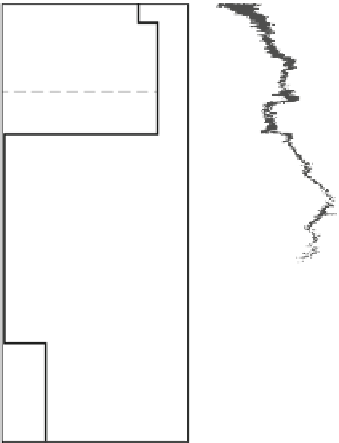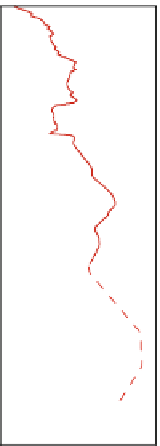Geology Reference
In-Depth Information
87
Sr/
86
Sr
Congo Fan volume (x10
4
km
3
)
ʴ
18
ʟ
(‰)
R
(Gradstein et al., 1994)
0
10
20
30
40
50
60
70
4
3
2
1
0
0.7075
0.7080
0.7085
0.7090
0.7095
0
.
GELASIAN
PLIO.
PIACENZIAN
0.732
0.746
ZANCLEAN
MESSINIAN
TORTONIAN
SERRAVALLIAN
LANGHIAN
0.7 million km
3
BURDIGALIAN
AQUITANIAN
CHATTIAN
Onset of
a
ccelerated off-shore sedimentation
RUPPELIAN
PRIABONIAN
BARTONIAN
LUTETIAN
50
YPRESIAN
THANETIAN
Basin starvation
SELANDIAN
DANIAN
MAASTRICHTIAN
CAMPANIAN
SANTONIAN
CONIACIAN
TURONIAN
CENOMANIAN
100
0.2 million km
3
Temperature (
o
C)
ALBIAN
0
4
8
12
APTIAN
Fig. 10.14
Comparison between the off-shore sedimentation history
of the Congo Fan (from Anka and S´ranne
2004
) and global proxies of
paleo-climate. The onset of Cenozoic accelerated off-shore sedimenta-
tion (
dotted blue line
) correlates with the transition from greenhouse to
ice conditions inferred from oxygen isotope records (from Zachos et al.
2001
) and the rapid increase in the
87
Sr/
86
Sr ratio of sea-water (from
McCauley and DePaolo
1997
) at the Eocene-Oligocene boundary. R
¼
Range in
87
Sr/
86
Sr of the on-shore CB red sandstones
the Kalahari duricrusts in response to wetter climatic
conditions following major global cooling during the
Eocene-Oligocene transition (e.g. Zachos et al.
2001
), and
doing so
been re-deposited regionally within the lower-lying, Ceno-
zoic to Recent alluviums of the central CB. Rapid prefer-
ential erosion of the red-beds of the CB, underneath the cap
rock Kalahari Surface, led to the rapid disintegration (cav-
ing) and collapse of this carapace across an area
the unconsolidated red-beds
(Fig.
10.12
). This may also have been further enhanced by
uplifts of the Angolan Highland (Walford and White
2005
;
Pritchard et al.
2009
; Roberts and White
2010
) and the
EARS between 20 Ma and 40 Ma (Lavier et al.
2001
; Pik
et al.
2008
; Roberts et al.
2012
).
'
flushing-out
'
10
6
km
2
(Fig.
10.12
). Initiation of the erosion of the CB can be
matched to the marine records of accelerated sediments
accumulation associated to the onset of the Congo Fan
during the Eocene-Oligocene transition (Fig.
10.14
). This
sudden regional
>
1
of sediment from on-shore to
off-shore may be linked to increasingly humid conditions
due to rapid global cooling at that time; since our initial
results of
87
Sr/
86
Sr of the red sandstones reveal very high
initial ratio and is consistent with the onset of rapid
increase in the
87
Sr/
86
Sr ratio of sea-water (e.g. McCauley
and DePaolo
1997
), which may not be solely related there-
fore to the onset of the Alpine-Himalaya uplift/erosion as
previously suggested (e.g. Raymo et al.
1988
).
'
transfer
'
Conclusion
The Kalahari Group overlies a subcontinental scale
peneplanation surface [the
]acrossthe
KP and the CB that resulted from significant exhumation
and erosion-weathering following the separation of Africa
from South America, during the opening of the South
Atlantic Ocean. On the top of the KP this major denudation
surface is capped (protected) regionally by a thin sequence
of terrestrial carbonates and calcretes (e.g. the Etosha and
Nxau-Nxau Calcrete Formations) covering Paleozoic and
Precambrian basement rocks. This lowermost Kalahari
carapace unit extends northward across the CB where it
merges with the
'
African Surface
'
Acknowledgments
We acknowledge funding through the Inkaba
yeAfrica and !Khure Africa programs, supported by the DST/NRF of
South Africa. B. Linol is particularly grateful to James Bruchs from his
invitations to the core shed of Tsodilo Resources Ltd. in Maun. Frank
Eckardt and Tyrel Flugel are thanks for their help with Figures
10.1A
and
10.2
. We also thank A. Tankard and G.A. Botha for valuable
reviews that improved the chapter. This is AEON contribution number
129 and Inkaba yeAfrica number 99.
that, in contrast,
overlies a thick sequence of poorly consolidated Jurassic-
Cretaceous red-beds. At the scarp marking the northern-
most extent of the KP, the Kalahari carapace is fragmented
and large boulders and pebbles of silcrete and calcrete have
'
Polymorph Sandstones
'



























































































































































































































Search WWH ::

Custom Search